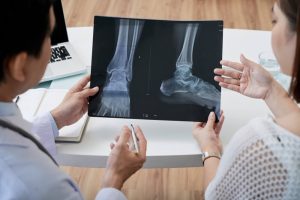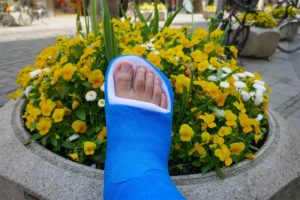Bunions are painful and frustrating conditions, but there’s hope! If you’re struggling with this issue, you’re not alone. At Foot & Ankle Specialty Centers, our 5 branches in Gilbert, Scottsdale, Chandler, Mesa, and Phoenix, Arizona, provide the best treatments to help you get back on your feet comfortably. You don’t need to search for “bunion surgery near me” anymore; we are here to help you.
What is a Bunion?
Also known as hallux valgus, it is a bony bump. This bump forms at the base of your big toe. This condition occurs when some of the bones in the front part of your foot move out of place. This placement change causes the tip of your big toe to go towards the smaller toes. If bunion pain is affecting your daily life, bunion surgery Phoenix may be the solution to restore comfort and function.
What are Bunion Treatments?
At Foot & Ankle Specialty Centers, we understand foot pain and inconvenience. Here are several treatments we recommend to help alleviate pain and potentially get rid of this condition:
- Wear proper shoes for bunions. The best shoes have a wide toe box, soft materials, low heels, and cushioned soles.
- Use bunion pads to cushion the affected area. These pads protect your foot from rubbing against your shoes.
- Custom shoe orthotics or inserts can help you position your foot correctly.
- Use anti-inflammatory drugs like ibuprofen (Advil, Motrin) or naproxen (Aleve) to reduce pain and swelling.
- Use ice packs on the affected area to reduce inflammation and numb the pain.
- Use toe separators to help keep the toes in the correct position.
- Correctors like splints or braces can realign the toes and joints. This realignment can gradually improve the positioning of your toe and lower pain.
- If non-surgical treatments are ineffective, we offer various options for bunion surgery Phoenix.

Bunions Symptoms
If you want the best bunions treatments, yah have to know the symptoms first:
Big toe turning inward | Bump on the side of the foot |
Pain or soreness | Red or swollen skin |
Stiffness in the big toe | Trouble fitting into shoes |
Calluses or corns | |
Types of Bunion Surgery
There are various minimally invasive options for bunion surgery Phoenix:
- Osteotomy involves cutting and realigning the bones of the big toe to their correct position. It helps restore normal toe alignment, reducing pressure and pain.
- Arthrodesis removes damaged joint surfaces and permanently fuses the bones. It eliminates joint movement and provides long-term pain relief.
- Exostectomy removes the bony bump from the toe joint without realigning the bones.
- Resection Arthroplasty involves removing part of the damaged toe joint to relieve pain. This surgery reduces pain and improves function and flexibility.
Bunion Surgery Before and After
Before the bunion surgery Phoenix, you may have:
- Constant and debilitating pain
- Pain, deformity, or difficulty when walking
- Difficulty in finding comfortable, well-fitting shoes.
After the bunion surgery Phoenix, you will have:
- Significant elimination or reduction in pain
- Better toe movement and foot function.
- The ability to wear more shoes comfortably
Click here to read more about flatfeet in Phoenix.
Bunion Surgery Recovery Time
Recovery times from the bunion surgery can vary depending on your case and the type of surgery:
- Initial healing usually takes about 6-8 weeks.
- The ability to return to normal activities is typically achieved within 3-4 months.
- Your complete recovery may take up to one year.

Bunion Surgery Cost in Phoenix
The cost of bunion surgery Arizona varies based on your condition and the type of procedure. Please contact Foot & Ankle Specialty Centers at 480-812-3668 to get detailed information and take the next step toward pain-free feet.
Best Bunion Treatment in Phoenix, Arizona
At Foot & Ankle Specialty Centers, our 5 branches in Gilbert, Scottsdale, Chandler, Mesa, and Phoenix, Arizona, offer comprehensive and personalized bunions on feet treatments. Our Bunion specialists can help you find pain relief and improve your quality of life. So, stop Googling “bunion doctors near me” and Contact us today at 480-812-3668 to schedule an appointment and take the first step towards pain-free feet.
FAQs About Bunion Treatment in Phoenix
How to shrink bunions naturally?
Use toe spacers, wear wide shoes, and do foot exercises to relieve pressure.
Do I need surgery for a bunion?
Not always. Many people manage bunions without surgery. We offer custom bunion treatment in Arizona to reduce pain and help you stay active.
How do I know if my bunion is getting worse?
If pain increases, your toe leans more, or your shoes stop fitting, it’s time to get help. Early bunion treatment in Phoenix can prevent serious issues.
Can you wear shoes after bunion surgery?
Yes, but usually, soft or supportive shoes are worn after healing begins.
Can bunions be corrected without surgery?
They can’t be fully corrected, but symptoms can be managed with orthotics and exercises.
Are Bunion Correctors Effective?
Yes, they can be effective in providing temporary pain relief and slowing the deformity progression.
Can I still be active if I have a bunion?
Yes! With the right bunion treatment, most people stay active. We help patients across Arizona keep moving without making the bunion worse.
Are Bunions in Children Normal?
Yes, though they are less common than in adults.
Related Blogs

What Are the Different Types of Bunion Surgery?
Bunions cause pain, swelling, and changes in how your foot looks. When other treatments do not work, surgery becomes the best option. Many people feel confused

How to Shrink Bunions Naturally?
One day, you may see a hard bump at the base of your big toe. Over time, it can grow and make walking or wearing shoes

Bunion Surgery Recovery Week by Week
Bunion surgery is a big decision, and it’s normal to wonder how long the bunion surgery recovery time will take. Most people aren’t worried about the

